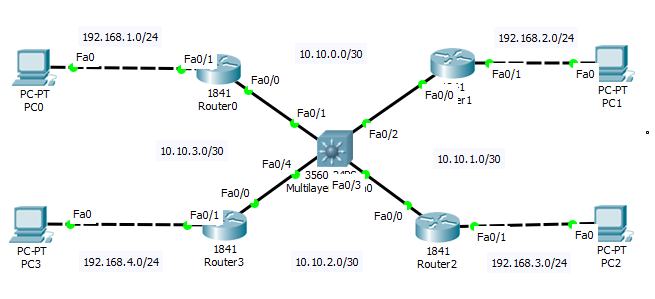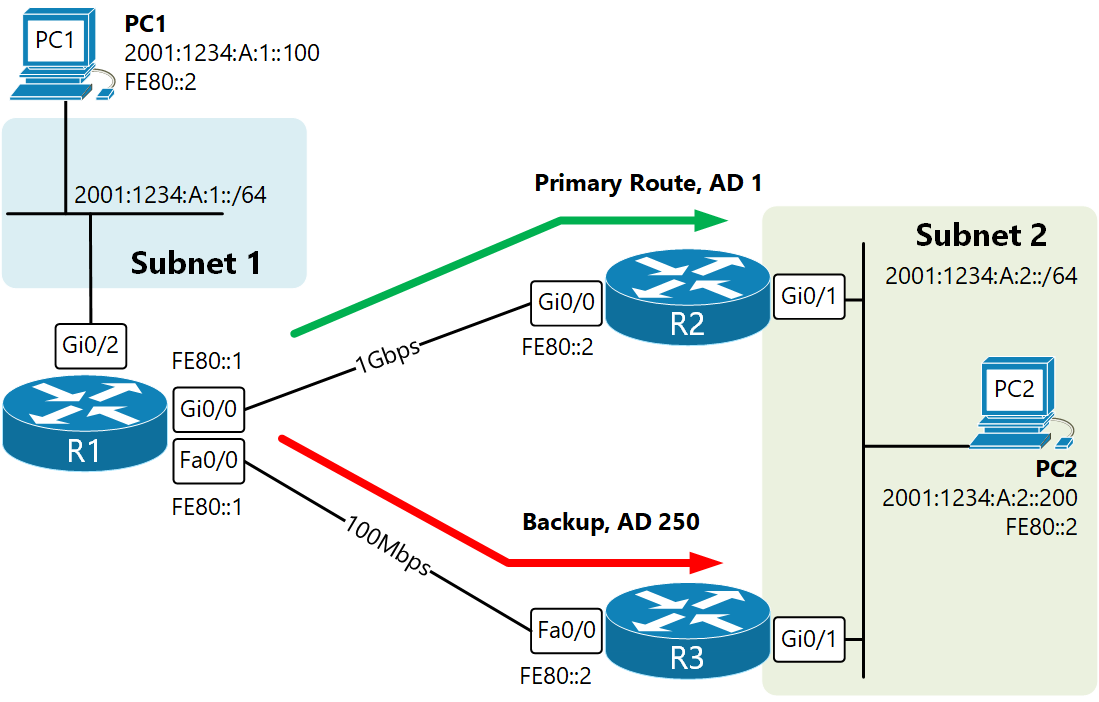eigrp,eigrp demo,eigrp costs,eigrp tests
SPOTO offers 100% real & valid Cisco, PMP, ISACA, AWS, and other IT exam dumps to help you pass IT
exams. We will list out eigrp tips, eigrp demo, eigrp tutorial, eigrp cost, eigrp latest industry news, all things you
concern about the Certification online proctored exam.
-
- 1075
- SPOTO
- 2024-06-20 15:33
-
- 720
- SPOTO
- 2024-06-19 17:29
eigrp,eigrp demo,eigrp costs,eigrp tests
SPOTO offers 100% real & valid Cisco, PMP, ISACA, AWS, and other IT exam dumps to help you pass IT
exams. We will list out eigrp tips, eigrp demo, eigrp tutorial, eigrp cost, eigrp latest industry news, all things you
concern about the Certification online proctored exam.
-
- 1075
- SPOTO
- 2024-06-20 15:33
Enhanced Interior Gateway Routing Protocol (EIGRP) is a dynamic routing protocol developed by Cisco, offering numerous advantages for network scalability, convergence, and efficiency. This blog post delves into EIGRP's technical nuances, aiming to introduce fundamental concepts and terminologies crucial for network engineers. EIGRP Basics and Evolution EIGRP evolved from the Interior Gateway Routing Protocol (IGRP), addressing its limitations such as slow convergence and lack of support for Variable-Length Subnet Masks (VLSM). Unlike IGRP, EIGRP is an advanced distance-vector protocol with features that significantly enhance its operational capabilities. EIGRP introduces mechanisms for faster convergence, loop prevention, and efficient routing information exchange. EIGRP Metrics: The Core Components EIGRP uses several metrics to determine the best path to a destination. These component metrics include: Bandwidth: The maximum rate at which data can be transmitted over a network path. Delay: The time it takes for data to traverse the path. Reliability: The likelihood of a path failing, based on historical data. Load: The amount of traffic currently being handled by the path. MTU (Maximum Transmission Unit): The largest size of data packet that can be sent over the network path without needing to be fragmented. Hop Count: The number of routers a packet must pass through to reach its destination. These metrics are combined using a composite metric formula, originally from IGRP, to determine the best route. This combination makes EIGRP more efficient than simpler protocols like RIP, which only use hop count . EIGRP Packets and Their Roles EIGRP relies on different types of packets to perform its functions: Hello Packets: Used for discovering and maintaining neighbor relationships. Hello packets are sent at regular intervals to ensure routers are still reachable. Acknowledgment (ACK) Packets: Sent to acknowledge the receipt of EIGRP packets, ensuring reliable communication. Update Packets: Carry routing information to all EIGRP routers. Updates are sent only when there is a change in the network topology, making EIGRP an efficient protocol. Query and Reply Packets: Used during the Diffusing Update Algorithm (DUAL) process to search for alternative paths when a route becomes unavailable. SIA-Query and SIA-Reply Packets: Used to prevent routes from getting stuck in an active state (Stuck-In-Active) by ensuring ongoing queries are still valid . Diffusing Update Algorithm (DUAL) At the heart of EIGRP is the Diffusing Update Algorithm (DUAL), which ensures loop-free and efficient route calculations. DUAL uses several key concepts: Feasible Distance (FD): The best known distance to a destination. Advertised Distance (AD): The distance reported by a neighbor to reach a destination. Feasibility Condition (FC): Ensures that a path is loop-free if the neighbor’s AD is less than the current router’s FD. Successor: The primary route to a destination. Feasible Successor: A backup route that meets the FC. DUAL ensures rapid convergence and minimizes routing loops by relying on these principles, making EIGRP robust in dynamic network environments . EIGRP Wide Metrics To support larger and more complex networks, EIGRP also includes Wide Metrics. These metrics expand the allowable range for component metrics, addressing limitations of the classic metrics. Wide Metrics provide greater granularity and flexibility in large-scale network deployments, improving path selection accuracy and network performance . EIGRP Named Mode EIGRP Named Mode simplifies the configuration process by consolidating all EIGRP-related commands under a single hierarchical structure. This mode organizes configurations into three sections: Address Family Section: Defines the protocol family (IPv4 or IPv6) and associated configurations. Per-AF-Interface Configuration Section: Contains interface-specific settings for the address family. Per-AF-Topology Configuration Section: Manages route redistribution, summarization, and other topology-related settings. Named Mode streamlines EIGRP management, making it easier to configure and maintain complex routing setups . Advanced EIGRP Features EIGRP offers several advanced features to enhance network performance and manageability: Stub Routing: Limits the scope of query messages to reduce unnecessary traffic and improve stability in large networks. Stub routers only advertise a subset of their routes, typically connected and summary routes. Route Summarization: Combines multiple routes into a single summary route, reducing the size of routing tables and improving efficiency. Unequal-Cost Load Balancing: Allows traffic to be distributed across multiple paths with different costs, enhancing bandwidth utilization and redundancy. Passive Interfaces: Prevents the sending of EIGRP packets on specific interfaces, enhancing security and reducing unnecessary overhead. Graceful Shutdown: Ensures a smooth shutdown of EIGRP on a router, preventing route flapping and ensuring network stability during maintenance operations . Securing EIGRP with Authentication To protect against unauthorized route updates, EIGRP supports authentication using MD5 or SHA-256 hashes. Authentication ensures that only trusted routers can participate in the EIGRP domain, safeguarding the integrity of routing information. EIGRP is a powerful and versatile routing protocol with a rich set of features designed to optimize network performance, scalability, and security. Understanding its core components, packet types, and advanced capabilities is crucial for network engineers seeking to build robust and efficient network infrastructures. By leveraging EIGRP's sophisticated metrics, DUAL algorithm, and advanced features, organizations can achieve high levels of reliability and efficiency in their network operations. -
- 720
- SPOTO
- 2024-06-19 17:29
IP routing is the process of moving packets across a network from a source to a destination. It involves various protocols and techniques to ensure efficient and reliable data transmission. Chapter 5 of the "CCIE Routing and Switching v5.0 Official Cert Guide, Volume 1" offers a comprehensive exploration of IP routing. This blog post will introduce key technical terms and fundamental concepts of IP routing, enabling readers to understand how data navigates through complex network infrastructures. What is IP Routing? IP routing is the mechanism by which data packets are forwarded from one network segment to another. It involves routers and routing protocols that determine the best path for data to travel across an interconnected network. Routers maintain routing tables that store the routes to different network destinations. Key Components of IP Routing: Routing Table: A database in a router that stores route information, including destination networks and the next hop to reach them. Routing Protocols: Algorithms and processes that routers use to communicate route information and select optimal paths. Next Hop: The immediate next device to which a packet should be forwarded on its way to the final destination. Static vs. Dynamic Routing Routing can be classified into static and dynamic routing based on how routes are determined and maintained. Static Routing: Definition: Static routing involves manually configuring routes in a router's routing table. Use Cases: Typically used in smaller networks or specific network segments where routes do not change frequently. Advantages: Simple and predictable. Disadvantages: Lack of scalability and flexibility, as manual updates are required for changes. Dynamic Routing: Definition: Dynamic routing uses routing protocols to automatically discover and maintain routes. Use Cases: Suitable for larger, complex networks with frequent topology changes. Advantages: Scalability, flexibility, and adaptability. Disadvantages: Requires more resources and introduces complexity. Common Routing Protocols Routing protocols are essential for dynamic routing, enabling routers to exchange information and determine the best paths for data packets. Here are some key routing protocols: RIP (Routing Information Protocol): Type: Distance-vector routing protocol. Metric: Hop count. Characteristics: Simple to configure, suitable for small networks, limited to 15 hops, updates every 30 seconds. OSPF (Open Shortest Path First): Type: Link-state routing protocol. Metric: Cost, based on bandwidth. Characteristics: Scalable, fast convergence, hierarchical design with areas, supports VLSM and CIDR. EIGRP (Enhanced Interior Gateway Routing Protocol): Type: Advanced distance-vector protocol. Metric: Composite metric (bandwidth, delay, load, reliability). Characteristics: Rapid convergence, supports unequal-cost load balancing, uses DUAL algorithm. BGP (Border Gateway Protocol): Type: Path-vector protocol. Metric: Path attributes (AS path, next hop, etc.). Characteristics: Used for routing between autonomous systems (inter-domain routing), highly scalable, supports policy-based routing. Route Redistribution Route redistribution involves sharing route information between different routing protocols within the same network. This process is crucial in networks that use multiple routing protocols, enabling seamless communication across different network segments. Key Concepts: Administrative Distance: A value that routers use to rate the trustworthiness of routes received from different routing protocols. Lower values are preferred. Redistribution Process: Configured on a router to import and export routes between different routing protocols. Routing Metrics and Path Selection Routing metrics are values used by routing protocols to determine the best path for data packets. Different protocols use different metrics, such as hop count, bandwidth, delay, load, and reliability. Path selection is based on these metrics to optimize network performance. Common Metrics: Hop Count: The number of routers a packet must pass through. Bandwidth: The data capacity of a link. Delay: The time taken for a packet to traverse a path. Load: The amount of traffic on a link. Reliability: The likelihood of a link failure. Route Summarization Route summarization, or route aggregation, is the process of combining multiple network routes into a single, summarized route. This technique reduces the size of routing tables, conserves bandwidth, and improves network efficiency. Benefits: Reduces Routing Table Size: Aggregates multiple routes, decreasing the amount of routing information that needs to be processed and stored. Enhances Performance: Simplifies routing decisions, reducing the processing load on routers. Improves Stability: Minimizes the impact of network changes on routing tables. Example: If a router has routes to 192.168.1.0/24, 192.168.2.0/24, and 192.168.3.0/24, it can summarize them as 192.168.0.0/22. IPv6 Routing IPv6 routing introduces new considerations due to the differences between IPv4 and IPv6 addressing. Routing protocols have been updated or developed to support IPv6. Key Points: IPv6 Addressing: Uses 128-bit addresses, vastly increasing the address space compared to IPv4. Updated Protocols: OSPFv3, EIGRP for IPv6, and MP-BGP support IPv6 routing. Dual Stack: Networks can run IPv4 and IPv6 simultaneously, requiring routers to handle both types of addresses and protocols. Routing Security Securing the routing infrastructure is critical to protect against threats such as route hijacking, spoofing, and denial of service attacks. Several techniques and protocols are used to enhance routing security. Key Security Measures: Route Authentication: Ensures that routing updates come from trusted sources. Examples include MD5 authentication for OSPF and BGP. Route Filtering: Controls which routes are accepted or advertised, preventing the propagation of invalid or malicious routes. Access Control Lists (ACLs): Restrict access to routing protocol communications based on IP addresses and other criteria. IP routing is a fundamental aspect of network design and operation, ensuring that data packets are efficiently and reliably delivered across interconnected networks. Understanding the principles of static and dynamic routing, routing protocols, route redistribution, metrics, summarization, IPv6 routing, and routing security is essential for network engineers and administrators. Mastery of these concepts enables the design and maintenance of robust, scalable, and secure networks, capable of supporting diverse and evolving communication needs.

